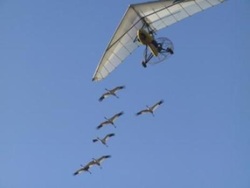
The whooping crane (Grus americana), is North America's largest bird, standing five feet tall, and one of its longest-lived, surviving 30 years or more in the wild. The species was near extinction in the 1940s, with fewer than 25 individuals. Today there is one flock of approximately 250 whoopers in the wild. This flock is the ONLY self-sustaining flock of whooping cranes in North America that migrate annually. This flock breeds in Canada and winters along the gulf coast of Texas.
The Whooping Crane Eastern Partnership, made up of government and non-profit experts, has been working since 2001 to establish a second population in the Eastern U.S., which now numbers more than 100 birds. Whooping cranes occurred naturally in the eastern United States until the mid-twentieth century, and there are records of whooping cranes in Florida until the 1930s. At Maryland's Patuxent Wildlife Research Refuge and other captive breeding sites, adult whooping cranes produce chicks and biologists hand-raise them, using special methods designed to prepare the chicks for life in the wild. Each summer in a Wisconsin marsh, experts train a group of captive-raised chicks to follow an ultralight aircraft, using techniques like those portrayed in the fictional 1996 movie "Fly Away Home" to lead them on a 1,300-mile journey to their Florida wintering grounds.
Only this first migration is human-assisted; from then on the young birds travel on their own, usually in the company of other whooping cranes. It appears that only one experienced bird per group is enough to keep the migration on track. Their movements are monitored daily via satellite transmitters, radio telemetry and on-the-ground observers. The result is a record of the movements of individual birds over several years, all with known parentage and the same upbringing.
The study shows the migration training for captive-born whooping cranes is working, Mueller said. However, the reintroduced whoopers are having trouble breeding in the wild. Based on the migration study's finding, "we need to take into consideration that these birds may also reproduce more successfully as they age," he said.
Given the whooping cranes' recent plunge towards extinction, it wouldn't be surprising if the birds need to re-learn how best to raise their chicks, said Patuxent-based scientist Sarah J. Converse of the U.S. Geological Survey, a co-author of the paper.
You can read the full article here: http://www.sciencedaily.com/releases/2013/08/130829145119.htm
The Whooping Crane Eastern Partnership, made up of government and non-profit experts, has been working since 2001 to establish a second population in the Eastern U.S., which now numbers more than 100 birds. Whooping cranes occurred naturally in the eastern United States until the mid-twentieth century, and there are records of whooping cranes in Florida until the 1930s. At Maryland's Patuxent Wildlife Research Refuge and other captive breeding sites, adult whooping cranes produce chicks and biologists hand-raise them, using special methods designed to prepare the chicks for life in the wild. Each summer in a Wisconsin marsh, experts train a group of captive-raised chicks to follow an ultralight aircraft, using techniques like those portrayed in the fictional 1996 movie "Fly Away Home" to lead them on a 1,300-mile journey to their Florida wintering grounds.
Only this first migration is human-assisted; from then on the young birds travel on their own, usually in the company of other whooping cranes. It appears that only one experienced bird per group is enough to keep the migration on track. Their movements are monitored daily via satellite transmitters, radio telemetry and on-the-ground observers. The result is a record of the movements of individual birds over several years, all with known parentage and the same upbringing.
The study shows the migration training for captive-born whooping cranes is working, Mueller said. However, the reintroduced whoopers are having trouble breeding in the wild. Based on the migration study's finding, "we need to take into consideration that these birds may also reproduce more successfully as they age," he said.
Given the whooping cranes' recent plunge towards extinction, it wouldn't be surprising if the birds need to re-learn how best to raise their chicks, said Patuxent-based scientist Sarah J. Converse of the U.S. Geological Survey, a co-author of the paper.
You can read the full article here: http://www.sciencedaily.com/releases/2013/08/130829145119.htm

 RSS Feed
RSS Feed
